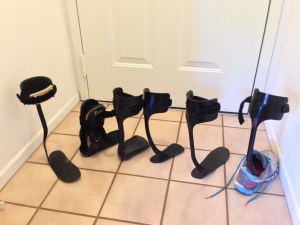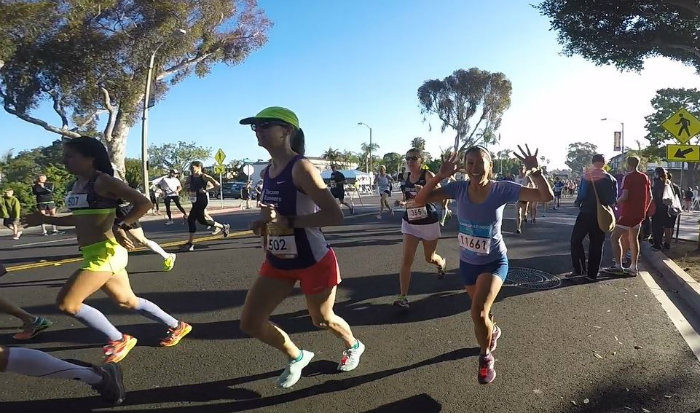(This post first appeared as one of my columns on www.multiplesclerosisnewstoday.com)
One of the MS blogs that I follow is written by Jen, who lives in England. It’s called Tripping Through Treacle. (Treacle is a thick, molassas-like, syrup). Doesn’t that neatly sum up the lives of many of us in just three, alliterative, words? From MS newbies to old timers like me, we worry (or have worried) about tripping. Many of us try to do something about that, however, and one of the options is to wear a brace.
AFOs
The formal name for these uncomfortable looking things is Ankle-Foot Orthosis, or AFOs. Jamie, who writes the Multiple Experiences blog, is trying an AFO right now to help with her foot drop, which is what trips up many of us. Well, she’s sort of using one. Jamie has told her blog followers that she “hates” the brace. She finds it inconvenient to use, especially because you need to take off your shoe, slip the AFO into that shoe strap it onto your shin, and put your shoe back on when you want to walk with it. This can be particularly cumbersome if you need it on your right leg, the leg that you use when you’re driving. Jamie says she’d rather use her walker but she plans to give the AFO another try in a couple of weeks with help from a physical therapist.
Working with a PT or, better yet, an orthotist is important. An orthotist is a specialist in making and fitting orthosis. After getting a prescription the orthotist will measure your leg and foot and the AFO is then custom-made from those measurements. Then the orthotist fits, tests and adjusts it before sending you back out into the world to walk with it.

An AFO is typically made from metal or plastic but some are made of strong, but lightweight, carbon fiber. Cheryl Hille, an MS patient who runs marathons and about whom I wrote several weeks ago, has half a dozen custom-made AFOs to use in various situations. I used an AFO a few years ago for a short period of time, (though I wasn’t running any marathons), until I “upgraded” to a Bioness L300 device.
FES Units
The Bioness L300 uses a cuff that straps to your leg under the knee cap. A pad in the heal of your shoe senses when you begin to try to raise your foot. It then sends a programmed,  low-level electrical stimulation that activate the nerves and muscles that raise your toes and lift the foot. (The process is known as Functional Electrical Stimulation, or FES). You’ll need a prescription for the L300 and a Bioness approved therapist will need to fit you and adjust the unit.
low-level electrical stimulation that activate the nerves and muscles that raise your toes and lift the foot. (The process is known as Functional Electrical Stimulation, or FES). You’ll need a prescription for the L300 and a Bioness approved therapist will need to fit you and adjust the unit.
I’ve used an L300 for about five years. At first, it worked so well that I was able to walk a city block without tiring, something that I hadn’t been able to do previously. With my cane I even walked up a grass covered hill, which was amazing. Alas, I don’t walk as well, over all, as I did five years ago and I’m now using two canes. I can’t do that hill anymore but without the Bioness strapped to my leg I wouldn’t be able to walk more than about 50 feet. I really depend upon it. The L300 can also be put into a “test” mode, which will trigger the stimulus while you’re sitting in a chair, so that you can exercise that leg muscle even when you’re not walking.
A similar unit is made by WalkAide. Unlike the Bioness unit’s sensor the WalkAide cuff, itself, senses your movement, so you don’t have to wear a shoe. I tried a WalkAide, briefly, when I was trying the L300 but I didn’t feel as stable with it as I did with the Bioness unit. Remember, both with AFOs and these FES units, each MS patient is probably going to have a different user experience. I’d recommend taking each device for a test walk, or two, before you buy.
Naturally, none of these devices are inexpensive. I think my custom-made carbon AFO cost about $800, which included the services of the orthotist. The L300 was selling for about $5,000 five or six years ago, but I was able to get a slightly used one for around $3,000. Insurance covered most of my AFO but it didn’t cover any of my FES. (That’s a rant for a future column).
If you’d like more information about all kinds of mobility devices, checkout the (U.S.) National MS Society’s web site.




I still am hating the braces. I like the FES they used on me but it’s not the wearable one it’s only to get the muscle moving. I’d like the wearable kind. They also have this thing called kickstart http://www.cadencebiomedical.com/ that does something similar to FES.